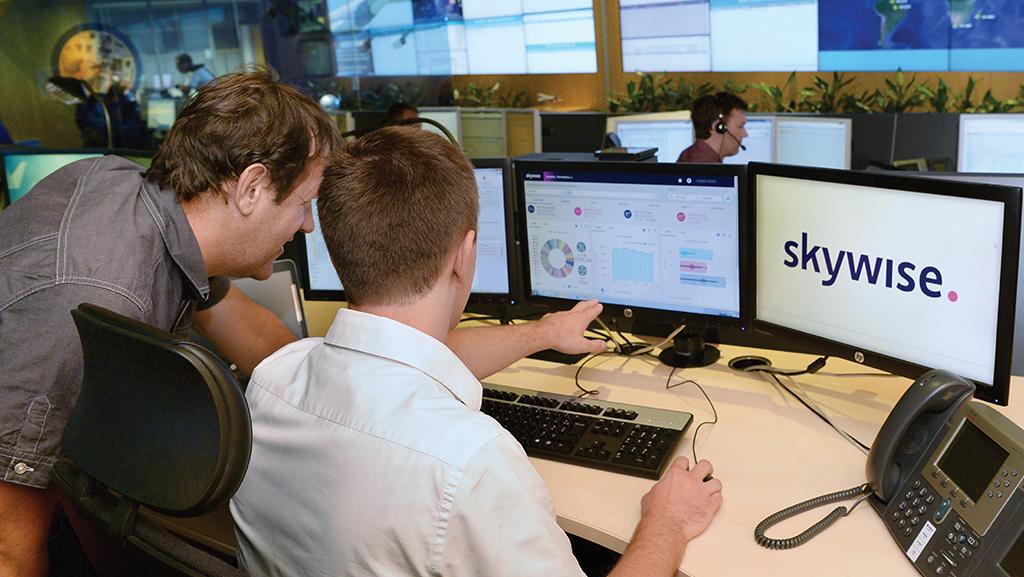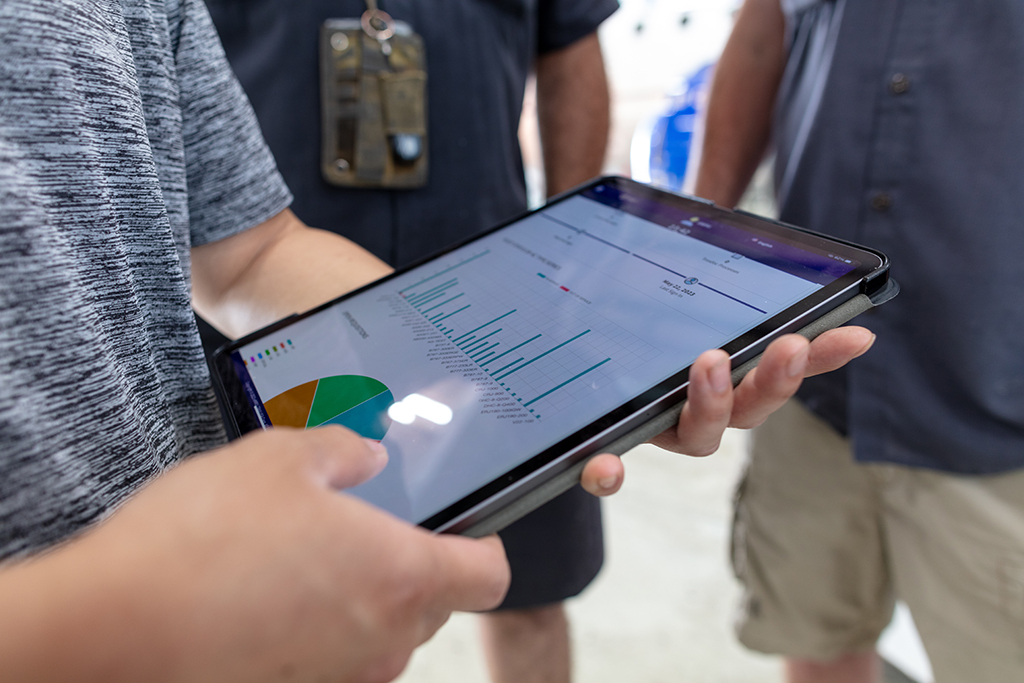
Skywise is designed to bring aviation data from multiple sources into this cloud-based platform.
While the aviation aftermarket has a long way to go to remove paper from its operations, subtle shifts in digital operations are underway—by MRO providers, airlines, OEMs and startups.
One of the most important of these is integration—enabling different systems to work together. Related to this are collaboration and data-sharing efforts.
Here are some examples of these growing trends.
Boeing: Streamlined Suite
Boeing hired Brad Surak earlier this year to streamline and integrate its digital offerings. In other words, to integrate and transform.
The OEM’s digital offerings include everything from Foreflight flight planning to Boeing’s Airplane Health Management system. “I think we tended to think in terms of features and functions” for products in the past, but now “the opportunity really is to anchor on the outcomes of those products” and “build more integrated suites of capabilities that help deliver those outcomes in a more friction-free way,” says Surak, vice president of digital aviation solutions.
Using an internal methodology dubbed Digital X, the starting point is to identify an airline’s pain points to understand the first step to tackle them—then, step by step, build a stairway to align with the airline’s transformation goals. “What can we do today to drive immediate impact for the airline, and then, what are the things that build upon that?” for moving toward a more digital airline in the future, Surak says.
For the past few months, discussions between the OEM and customers have focused on this journey, instead of on selling products or services. “How do daily operations transform with analytics, and how does that pragmatically roll out in a set of steps,” as opposed to a big “rip and replace of the software that they have,” he says.
Surak’s previous experience at companies such as GE Digital and SAP taught him that this more gradual stairway to value process is more effective than the “big bang” approach.
To switch to the stairway approach, Boeing is reevaluating its digital portfolio to see how it can deliver a technology stack to enable those integrated operations transformations.
Digital X delivers a “language and a set of practices” to be used throughout the organization—from product managers to designers and engineers—to ensure “they are all thinking about customer outcomes.”
Boeing’s products won’t disappear, but “we’re making them work better together,” he says. “We’re starting from wherever they’re at, and then starting to layer in capabilities to unlock those value propositions, step by step,” he summarizes.
That means instead of buying three or four products today to achieve a result in the future, Boeing could deliver an integrated suite that would be easier to implement and deploy, and tailor it to the customer’s desired outcomes.
That suite might include technologies from many partners, because “we have to work within a very complex environment that the customer has,” and everything has to integrate from it to be an optimized ecosystem, he emphasizes.
AAR/Trax: Parts Ecosystem

Since AAR purchased MRO software provider Trax on March 20 for $120 million, it has learned more about Trax than what it knew in the due-diligence stage.
For instance, Trax has several initiatives under development—including apps for its E-Mobility Suite, a hosting service and artificial intelligence (AI) applications, says John Holmes, AAR’s president, CEO and chairman.
“It’s not just because the flavor of the day is AI. They’re actually using AI to automate MRO and maintenance tasks down the road,” he says.
In addition to growing Trax’s core business, AAR sees an opportunity to create a parts ecosystem to streamline parts purchasing.
“Access to parts in the aviation market is so critical” whether it’s an AOG situation, a routine part of a heavy check or a component repair—and “all of these activities happen thousands and thousands of times every day around the world, yet it’s still fairly disjointed,” Holmes says.
That’s where AAR’s parts ecosystem idea comes in.
While using systems like Trax, its 138 airline customers have to leave their purchasing system to find parts. AAR sees an opportunity to integrate those functions by “building access to the parts world and integrating it with Trax so that a buyer or planner can transact right in Trax, as opposed to going out and searching multiple sources, such as ILS, PartsBase, Aeroxchange and others,” Holmes says.
To ensure that the parts are available and are legitimate, “we want to bring to the parts world what Amazon, Uber and others have the brought to the consumer world,” including confidence in availability, delivery date, price and correct documentation.
That means setting up a trusted supplier network, similar to five-star Uber drivers, where the buying community would vet and rate the suppliers in this network.
The Trax team is starting to build this functionality. AAR anticipates using a third party to look at the ratings and potentially help curate this, says Andrew Schmidt, AAR’s senior vice president for digital services and Trax.
At this point, the company is thinking of rolling it out as the ecosystem of the Trax customer, so the “Trax customer decides which suppliers are in their ecosystem,” Schmidt adds.
“We hope to ultimately show that the direct access to the buying community—and the value of this trusted supplier network—is worth participating in as a supplier,” Holmes says.
Lufthansa Technik/AMOS/Flydocs: Tech Ops Ecosystem
Another blending of digital services to increase efficiencies happened recently at Lufthansa Technik. The MRO integrated Swiss Aviation Software, which provides the AMOS MRO software, and Flydocs, an asset management solution, with its Aviatar platform to create the Digital Tech Ops Ecosystem.
The intent is to “connect the dots between the modularly designed solutions” so data can flow seamlessly across the system and customers’ technical operations, says Philip Mende, Lufthansa Technik’s vice president for digital fleet services.
Doing this should “reduce MRO costs, enhance process efficiencies, increase operational stability and aircraft availability, and also optimize asset values,” he says.
Mende says the Digital Tech Ops Ecosystem is open for collaboration and links to external digital solutions. He also stressed that it is modular, neutral and secure—and customers have “full control and ownership of their data.”
Digital data solutions in the aftermarket are frequently fragmented, so joining Aviatar, AMOS and Flydocs together should streamline workflows.
Skythread: Data Sharing
Skythread can be classified as a blockchain play, “but what we’re really, really, really focused on doing is not saying blockchain is the answer to everything . . . but solving for trust and data sharing,” says CEO Mark Roboff.
To leverage digital information and MRO, he says the first problemto solve is how to motivate the industry to freely share data in a friction-free environment.
For instance, many entities can have fragmented pieces of an engine part’s data—from the OEM, to the airline, to the MRO and lessor—across its life cycle. So to really scale digitally in the aftermarket, “it’s about getting the data together” in an ecosystem where people can share the data freely to create a comprehensive history, Roboff says.
Skythread intends to be a secure, neutral data network and initially is focused on parts tracing. Its data governance is defined by a new industry group, the Independent Data Consortium for Aviation, announced at the Paris Air Show in June.
The consortium’s board includes Airbus, Parker Aerospace, Safran, Collins Aerospace, Lufthansa Technik and Air France-KLM E&M.
The Other Part of Air India’s Big Order
Air India made a big splash at the Paris Air Show when it ordered 470 Airbus and Boeing aircraft valued at $70 billion at list prices. What didn’t get as much attention was that it also signed an agreement with Airbus and Boeing for digital services.
Air India will become the launch customer for Airbus’ Skywise Core X3 advanced analytics platform, and it also signed up for Integrated Materials Solution deal with Satair for parts. The Core X3 product includes machine learning and features “designed to accelerate the digital transformation of our customers and integrate Skywise with their IT landscape,” says the OEM.
The new agreement with Boeing Global Services includes parts provisioning, training programs, 787 interior upgrades and various digital crew management solutions from Jeppesen.
Air India’s five-year transformation road map, called Vihann.AI, includes fleet renewal and other steps to become a world-class airline. As part of this initiative, it plans to invest $200 million in digital upgrades and technology.
